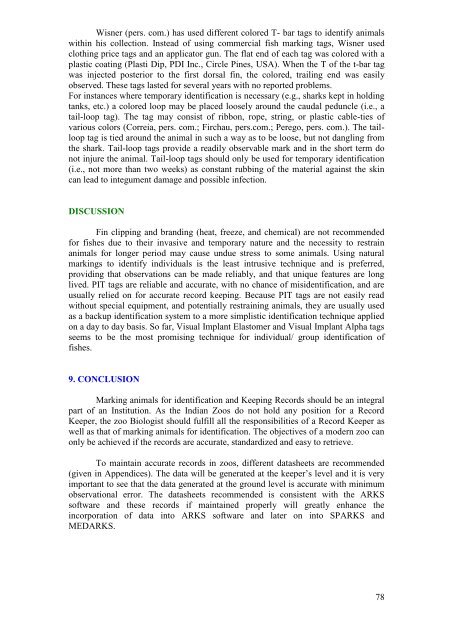standardization of records keeping in indian zoos - Central Zoo ...
standardization of records keeping in indian zoos - Central Zoo ...
standardization of records keeping in indian zoos - Central Zoo ...
You also want an ePaper? Increase the reach of your titles
YUMPU automatically turns print PDFs into web optimized ePapers that Google loves.
Wisner (pers. com.) has used different colored T- bar tags to identify animals<br />
with<strong>in</strong> his collection. Instead <strong>of</strong> us<strong>in</strong>g commercial fish mark<strong>in</strong>g tags, Wisner used<br />
cloth<strong>in</strong>g price tags and an applicator gun. The flat end <strong>of</strong> each tag was colored with a<br />
plastic coat<strong>in</strong>g (Plasti Dip, PDI Inc., Circle P<strong>in</strong>es, USA). When the T <strong>of</strong> the t-bar tag<br />
was <strong>in</strong>jected posterior to the first dorsal f<strong>in</strong>, the colored, trail<strong>in</strong>g end was easily<br />
observed. These tags lasted for several years with no reported problems.<br />
For <strong>in</strong>stances where temporary identification is necessary (e.g., sharks kept <strong>in</strong> hold<strong>in</strong>g<br />
tanks, etc.) a colored loop may be placed loosely around the caudal peduncle (i.e., a<br />
tail-loop tag). The tag may consist <strong>of</strong> ribbon, rope, str<strong>in</strong>g, or plastic cable-ties <strong>of</strong><br />
various colors (Correia, pers. com.; Firchau, pers.com.; Perego, pers. com.). The tailloop<br />
tag is tied around the animal <strong>in</strong> such a way as to be loose, but not dangl<strong>in</strong>g from<br />
the shark. Tail-loop tags provide a readily observable mark and <strong>in</strong> the short term do<br />
not <strong>in</strong>jure the animal. Tail-loop tags should only be used for temporary identification<br />
(i.e., not more than two weeks) as constant rubb<strong>in</strong>g <strong>of</strong> the material aga<strong>in</strong>st the sk<strong>in</strong><br />
can lead to <strong>in</strong>tegument damage and possible <strong>in</strong>fection.<br />
DISCUSSION<br />
F<strong>in</strong> clipp<strong>in</strong>g and brand<strong>in</strong>g (heat, freeze, and chemical) are not recommended<br />
for fishes due to their <strong>in</strong>vasive and temporary nature and the necessity to restra<strong>in</strong><br />
animals for longer period may cause undue stress to some animals. Us<strong>in</strong>g natural<br />
mark<strong>in</strong>gs to identify <strong>in</strong>dividuals is the least <strong>in</strong>trusive technique and is preferred,<br />
provid<strong>in</strong>g that observations can be made reliably, and that unique features are long<br />
lived. PIT tags are reliable and accurate, with no chance <strong>of</strong> misidentification, and are<br />
usually relied on for accurate record <strong>keep<strong>in</strong>g</strong>. Because PIT tags are not easily read<br />
without special equipment, and potentially restra<strong>in</strong><strong>in</strong>g animals, they are usually used<br />
as a backup identification system to a more simplistic identification technique applied<br />
on a day to day basis. So far, Visual Implant Elastomer and Visual Implant Alpha tags<br />
seems to be the most promis<strong>in</strong>g technique for <strong>in</strong>dividual/ group identification <strong>of</strong><br />
fishes.<br />
9. CONCLUSION<br />
Mark<strong>in</strong>g animals for identification and Keep<strong>in</strong>g Records should be an <strong>in</strong>tegral<br />
part <strong>of</strong> an Institution. As the Indian <strong>Zoo</strong>s do not hold any position for a Record<br />
Keeper, the zoo Biologist should fulfill all the responsibilities <strong>of</strong> a Record Keeper as<br />
well as that <strong>of</strong> mark<strong>in</strong>g animals for identification. The objectives <strong>of</strong> a modern zoo can<br />
only be achieved if the <strong>records</strong> are accurate, standardized and easy to retrieve.<br />
To ma<strong>in</strong>ta<strong>in</strong> accurate <strong>records</strong> <strong>in</strong> <strong>zoos</strong>, different datasheets are recommended<br />
(given <strong>in</strong> Appendices). The data will be generated at the keeper‟s level and it is very<br />
important to see that the data generated at the ground level is accurate with m<strong>in</strong>imum<br />
observational error. The datasheets recommended is consistent with the ARKS<br />
s<strong>of</strong>tware and these <strong>records</strong> if ma<strong>in</strong>ta<strong>in</strong>ed properly will greatly enhance the<br />
<strong>in</strong>corporation <strong>of</strong> data <strong>in</strong>to ARKS s<strong>of</strong>tware and later on <strong>in</strong>to SPARKS and<br />
MEDARKS.<br />
78
















